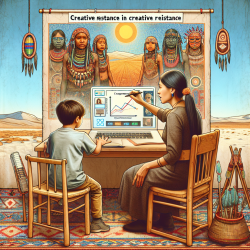In the field of speech-language pathology, creating effective interventions for children often involves thinking outside the box. A recent research article, "Desire and the Law: Creative Resistance in the Reluctant Passenger and the Heart of Redness," offers fascinating insights that can be applied to our practice. The study emphasizes the power of desire and indigenous knowledge as creative alternatives to traditional legal frameworks. Here’s how you can harness these insights to improve your practice.
1. Embrace Creative Resistance
The research underscores the importance of creative resistance—working within and beyond traditional frameworks to achieve desired outcomes. In speech-language pathology, this can translate to developing innovative therapy techniques that resonate with a child's unique cultural and personal experiences.
- Example: Instead of relying solely on standardized tests, incorporate storytelling and play-based assessments that align with the child's cultural background.
2. Incorporate Indigenous Knowledge
The study highlights how indigenous environmental knowledge can challenge conventional approaches. Similarly, incorporating culturally relevant practices and knowledge into therapy can enhance engagement and outcomes.
- Example: Use culturally significant stories or traditional games to build language skills. This not only makes therapy more engaging but also fosters a deeper connection with the child.
3. Foster a Broader Sense of Community
The research emphasizes understanding community in a broader sense, including both human and non-human elements. In speech-language pathology, this can mean involving family members, teachers, and even pets in the therapy process to create a supportive environment.
- Example: Develop home-based activities that involve siblings or pets, making therapy a more integrated part of the child's daily life.
4. Think Beyond Legal Frameworks
The study critiques the limitations of relying solely on legal frameworks for protection and suggests that desire and creative alternatives can offer more effective solutions. In our practice, this can mean advocating for policies that support holistic and culturally sensitive approaches to therapy.
- Example: Advocate for school policies that allow for flexible therapy sessions tailored to individual needs rather than rigid schedules.
Encouraging Further Research
While the study provides valuable insights, it also opens the door for further research. As practitioners, we should continuously seek out new knowledge and approaches to enhance our practice.
- Example: Conduct small-scale studies within your practice to test the effectiveness of incorporating indigenous knowledge and creative resistance in therapy.
To read the original research paper, please follow this link:
Desire and the Law: Creative Resistance in the Reluctant Passenger and the Heart of Redness.










